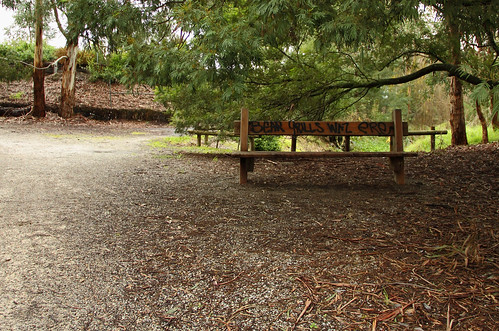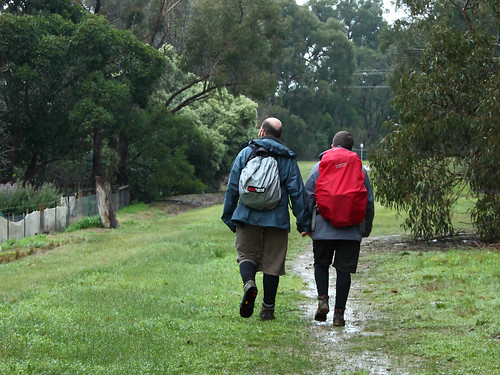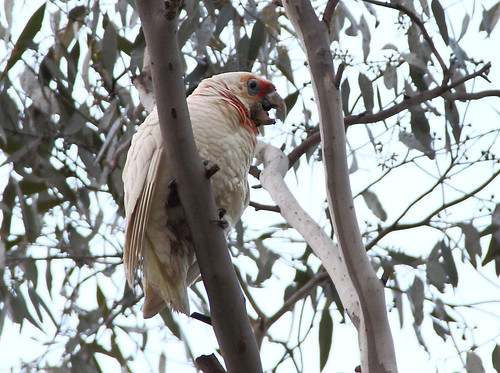Ringwood to Lilydale
23km / Approx 7 hours
Map
My photos

G, J & D just beside the freeway in Ringwood: our ‘before’ picture
“A shift in atmosphere or perspective”. That’s what I wrote in the first post in this series about walking out of the city, thinking about boundaries and subtle borders that only appear obvious in the crossing. The shifts I’ve mentioned so far have been from inner to middle suburbia (and now from older to newer outer suburbia), from river- and creek-side paths to roadside walking, from more-accessible to less-accessible terrain, from familiar to less-familiar, from MFB to CFA territory and back again, from the hard surfaces of asphalt to loose gravel or soft grass underfoot, from residential to agricultural/horticultural land use, from the solid, regimented lines of human construction to the more relaxed, fluid shapes of ‘nature’. And all the while, the boundary most obvious is between city and not-city.

Bear Grylls would surely not go adventuring in the city! We must have entered the wilderness! (Photo by GT)
In all of this walking and investigation I wonder if, more often than not, I have been searching for a spatial border (or borders)? Or have I been walking to the (re)realisation that physical, geographic, cartographic and administrative circumscriptions are only one way of locating a city? I’ve been reading Benedict Anderson on imagined communities, and although he uses this phrase to refer to nations, the concept might also be applied and adapted to any number of networks, groups, communities – including that of ‘the city’. In this formulation, then, spatial boundaries are only one way of imagining the city. Other imaginings occur through music (songs like Carlton (Lygon St Limbo) or Four Seasons in One Day, or one of these other songs), or sport (an imagining of the city through AFL or VFL clubs, for example), or news about violence (gangland killings, anyone?), or the daily interactions we have with other people in schools, shops, workplaces, on roads or bike paths, with cleaners or bankers or ticket inspectors (“I suggest you take a long hard look at the reflection of yourself in the tram window in your deceptive, unattractive plain clothing uniform and ask yourself,” recites Yana Alana, “Was it always my dream to become a ... motherfucker?”). This is the city as imagined through the circulation of local newspapers, the dissemination of home delivery menus, discussions of the weather, the suggestions to visitors that they try this restaurant or that bar, wearing of badges with Melways maps on them, community mapping projects like ToilArt and Feral Fruit Trees, coffee snobbery (which has surfaced a few times in this series of posts!) and speculation about whether ‘we’ will vote Green in the next election now that Lindsay Tanner is resigning. The urban city might be imagined in relation to the suburban sprawl, rural farmland or remote bush. Melbourne might be imagined in relation to Sydney (From St Kilda to Kings Cross) or Adelaide, in relation to Victoria, in relation to Australia – or in relation to major cities in Melbournians’ countries of birth (UK, Italy, Vietnam, China, New Zealand, Greece, India, Sri Lanka, Malaysia and the Philippines were the top 10 in the 2006 census). Present-day Melbourne might be imagined in relation to Melbourne of 20 years ago (see the clip for the Skyhooks’ Lygon St Limbo, above), or the colonial town of 150 years ago, or the pre-colonised land of the Wurundjeri, Bunerong and Wathaurong people. At any rate, this Melbourne and this idea of the city coheres around psychic and interactive (person to person, to environment, to institution, etc) elements, rather than being circumscribed by spatial boundaries . . . in which case, how might one walk out of the city?

The back blocks of Ringwood, next to the Mullum Mullum path

Eucalyptus of some description, Croydon Hills

Croydon Hills. (Photo by GT)
Perhaps it’s that as we walk further ‘out’, I walk further from ‘my’ city, the place where I spend my everyday. This much is obvious in my continued surprise at the suburb of Ringwood – mentioned last time as being quite nice, really, and living up to that standard during this leg of our walk. We used the facilities in Eastland (what an exciting experience!), then headed to the Mullum Mullum path, ducking under the freeway and heading into the quiet Saturday morning suburbs. We saw Maned Wood Ducks, some mallards, lots of joggers and dogs – including one adorable black puppy called Bella, who was very friendly and happy to meet ALL THE PEOPLE EVER! After about 6kms, we left the creek and followed streets (mostly with footpaths, unlike our road-walking sections through Park Orchards last time!) for a few Ks to the section of bushland called Hochkins or Hodgkins Ridge Flora Reserve. We weren’t sure that there’d be tracks through the reserve, but luckily there were (for anyone following our footsteps, you need to take the second gate into the reserve – the first path leads down to the creek). The rain that had been threatening all day finally descended before we had the opportunity to break out the thermoses – we were really hanging out for a cuppa by the time we got to our lunch break a few kilometres later. In the interim we enjoyed the rest of our time in the reserve, then turned east along the road at the northern end. My Melways says that this is the proposed route for a northern arterial road, so we made sure to enjoy the peace and quiet and our ability to meander across the grass by the roadside, because in a few years time it might be gone. Turning south again, we passed by a primary school and – more interestingly – some hilarious goats, before finally trudging to the shops on Exeter Rd in Croydon North and settling in under the shelter of the op shop verandah for food and tea.

D&G before the rain settled in, walking through Hochkins Ridge Flora Reserve

G&D with hoods up against the rain, a few minutes later!

GOAT!!!

Food and shelter! Excellent!
The differences between here and, say, Thornbury at the start of this walk, are quite significant. Although we might both consider ourselves Melbournians (or Melburnians, if you prefer that spelling), my Melbourne is going to be very different to the Melbourne of someone who lives in a big house in Croydon North (not an apartment in the inner northern suburbs), commutes to a full time job in one of their cars (not to a part time job on the tram or to uni on foot), who sees the city from wide suburban streets, a freeway or bypass (instead of from laneways, bike paths and CBD streets), who drives their kids to school, sport or music lessons (no kids, no car) . . . We sat under the verandah and watched this other world go by. People said hello to us, smiled, or rushed to their cars as the rain picked up again. We wondered how much our white/age/class privilege allowed us to set up here and have a picnic lunch where others might be less welcome or more likely to be told to move on and stop loitering.

I thought some of the Esthers in my life might like this!
Having talked about how my imagining of ‘the city’ might differ from someone else’s, I should also mention that my own ideas of ‘the city’ and of Melbourne are also in constant flux. When I was a kid, my family used to drive 400+kms from the bush in East Gippsland to Melbourne to visit family during school holidays. Mostly we would stay with my Oma, and I remember ticking off towns and getting more exciting the bigger they became: Bairnsdale, Sale, Traralgon, Moe (almost an outer suburb in my mind!), Berwick (definitely in Melbourne!) and then finally our destination – the overwhelming metropolis of Croydon! To me, the area around Croydon was Melbourne, it was the city, and I could barely differentiate between Croydon and the CBD (the only real difference was that the big gallery was in the latter, and the trains went underground). It’s funny to think that now Croydon registers as an outer suburb to me – meaningful only in memory (“I know where we are,” I said as we crossed the end of Dorset Road, knowing I could walk a few kilometres – right on Lincoln Rd, left on Croydon Rd – and be at Oma’s house . . . only it’s not Oma’s house any more, and I would probably have cried), and in relation to other places (it now seems so close to the Dandenong Ranges National Park – a favourite walking haunt of ours). It’s also strangely familiar and unfamiliar now, because not only have things actually changed, but my perspective on them has changed, particularly as a walker rather than a passenger in the back seat of a family car.

D in Mooroolbark. I thought I was being very amusing making him pose for this photo.

We walked a few kilometres along the path of this pipeline.

You can see all the new suburbs springing up before your eyes. And hardly a solar panel in sight.

Consulting the map! (Photo by GT)

And off we go! (Photo by GT)
Walking along the pipe reserve reminded me a bit of walking to Epping - and how interesting that the linked post also talks about the yearning to walk out of the city! I realised that this ‘reminds me of’ game is one that I’ve been playing since we left Eltham, since we started walking where we’d never been before. I guess most people do this without thinking: “This street in Melbourne reminds me of that street in Berlin”, “These tube station names in London remind me of suburbs in Melbourne”. This seems to create a psychic palimpsest of the city – the London underground map sits distorted over Tottenham and South Kensington, the Rose St market in Fitzroy sometimes merges into the flea market in East Berlin, the smell of coffee and sewerage near the Queen Victoria Market invokes echoes of Barcelona, the crowds of tourists in Fed Square (FEDDO!) pale in significance with the claustrophobic summer throngs of Rome or Venice, and whenever I travel on the Tullamarine Freeway I get a little thrill of travel excitement and remember all the other airports I’ve been through in Singapore, Canada, Japan, New Zealand, Hong Kong, London, Abu Dhabi, Amsterdam . . . This city is personal, psychological, emotional, and clearly a result of individual circumstance.

Street art – another thing Melbourne is known for. Although usually it’s the art in the inner city laneways that gets all the attention.
Well, this post has been rather heavy on the abstract, and hasn’t focussed as much on the actual walking experience! I suppose that story comes through more in the photos and captions (it’s rather like a supplement in a Derridean sense – OMG theory wanker!). It was, overall, a really lovely walk through some unfamiliar (to us) territory. We all enjoyed the Olinda Wetlands and Lilydale Lake in particular. In fact, the last section of the walk was probably the most spectacular, which is always a good way to end! Lilydale Lake was a wonderful mirror of the sky as the cloud lifted, the rain stopped, the sun set and evening fell, and we agreed that the lake and wetlands would make a lovely afternoon outing for a picnic in drier weather.

Olinda Wetlands

We joked that we’d walked on the toe-hills (rather than the foothills) of the Dandenongs, but the heavy cloud meant we didn't really get to see the hills for most of the day. The cloud only started to clear towards the end.

Long-billed corella making a racket in the tree beside our picnic table. (Photo by GT)

Lilydale Lake – how’s the serenity?!

There are even little beaches around the side of the lake!
This day of our walk to Warburton, alongside the reading I’ve been doing, has lead to a shift in my perspective. In a way, I am now inclined to see the line that our footsteps have traced as evidence of the city (my city) expanding, and also as part of an extension of what ‘the city’ in general (and ‘Melbourne’ in particular) means to me.

Tired out after a long day. The train ended up packed with Collingwood supporters on the way to the Saturday night game at Docklands – what did I say about Melbourne being imagined as footy town? It’s true!
GORGEOUS PICS ARE GORGEOUS.
ReplyDeleteQuestion: is there a link to a map of the walk you did? Geographic context, I crave it!
thanks! yes, at the very start of the post, click on the word 'Map' and it will link you to the route on mapmyhike.com
ReplyDeleteHow terribly splendidly lovely! Wonderful photos! Your meditation on walking out of the city is a fitting antidote to the disappointment (alas!) of Gryff's Sydney profile on tv last night. Which I suppose was bound to happen.
ReplyDeleteAnd isn't it curious - how concepts of place become elastic over time as you consult your memories and perspectives.
hello gaylourdes, darling! i am so pleased you enjoyed reading this, because it is partially inspired by the walking-writing of the book (wanderlust) you sent me as a gift.
ReplyDeleteyes - the cities program is interesting, isn't it? it always has moments of "how exotic", moments where one wonders how very lightly the show scratches the surface, how much the colonial/imperial/english/european/middle-upper class sensibility affects what is shown and said . . . but to have it confirmed in a familiar city is still pretty odd, isn't it? "ha ha ha aussies all drink beer! and don't mention the genocide!"